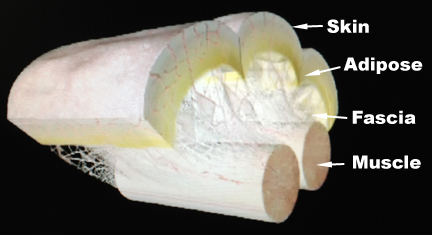Learn More About Fascia
We recently watched this amazing video (see clip above) from Dr. Jean-Claude Guimberteau, MD called “Interior Architectures.” The video explores the fascial connections and connective tissue within our bodies using an HD camera and clearly demonstrates just how integrated our tissues really are.
For those of you who have heard David, our Injury Specialist, lecture at his Anatomy Trainings, you’ve often heard him discuss how everything is connected thru fascia. How the images we see in most anatomy books are too “clean” and don’t fully acknowledge or represent how integrated and connected our bodies really are. This video and the images below should help give you a better idea of what we, as massage therapists, “see” when working with our clients/patients.
 Quotes from Dr. Jean-Claude Guimberteau:
Quotes from Dr. Jean-Claude Guimberteau:
“The body is one & has the same multifibrilla architecture.”
“Everything is in continuity, everything is connected, everything moves to fit, everything moves and always comes back to its previous position.”
“Water is everywhere & present in all tissues. It is 85% of our body weight. We have a constant volume but variable pressure in different areas.”
Myofascial Release:


These 2 images illustrate our fascial layering and connections. The image on the left (taken from the video above) shows how the skin, adipose and muscle are all connected thru the superficial (surface) fascia. Note how the fascia looks like a spider web wrapping and connecting the layers together.
The image on the right, while “clean” in it’s representation, shows how a tendon from one muscle integrates into the next tendon thru fascial connections. They are physically connected and not as separate as many illustrations incorrectly represent. Also, both tendons would connect at the bony attachment thru the periosteum (the “skin” of the bone) creating a truly integrated body.
When we, as massage therapists, apply myofascial release, we are attempting to manually unwind fascial lines and connective tissue that get stuck together and negatively affect our movement patterns. We see the body as an integrated system of connective tissue and look to unwind improper biomechanical “patterns” in the body.
Fascia & Skin:


Dissection of the skin & superfiscial fascia
The image on the left shows a detailed cross-section of the fascial layering and corresponding criss crossing retinacula cutis fibers. They’re all considered fascia or connective tissue, each with slighly different fiber orientations. Note how the dissection on the right shows many of the retinacula cutis fibers which appear like a spider web connecting the skin to the deeper layers.
 The Video
The Video
Our thanks goes out to Tom Meyers for bringing this video to our attention. And our sincere gratitude to Dr. Guimbertau for his pioneering work and wonderful video. To purchase this video, click here.

